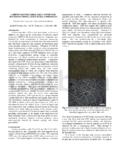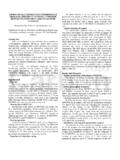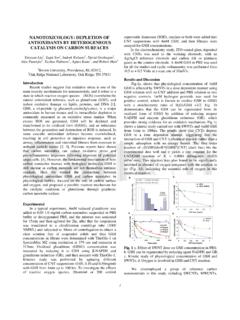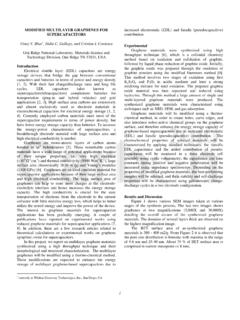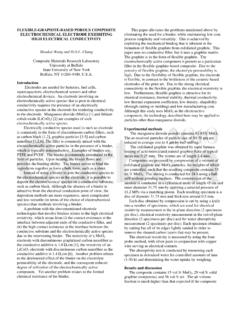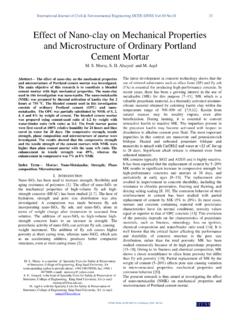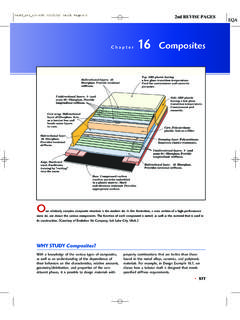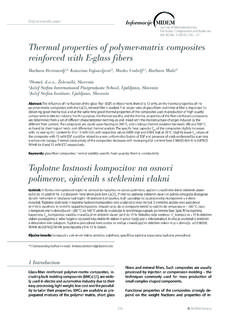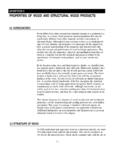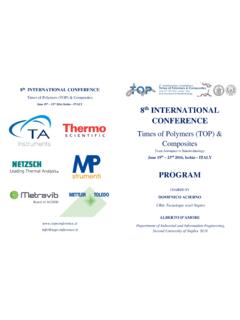Transcription of 2010: EXFOLIATED GRAPHITE FOR ENHANCING THE …
1 EXFOLIATED GRAPHITE FOR ENHANCING THE VIBRATION DAMPING OF CEMENT-MATRIX AND POLYMER-MATRIX STRUCTURAL MATERIALS Seungjin Han, S. Muthusamy, Po-Hsiu Chen, Shoukai Wang and Chung Composite Materials Research Laboratory University at Buffalo State University of New York Buffalo, NY 14260-4400, Introduction The damping of mechanical vibration is important for the stability, performance and durability of structures, including aircraft, spacecraft, wind turbines, bridges and buildings. Damping can be achieved by using materials that are capable of the conversion of mechanical energy to heat, so that the mechanical energy is eliminated.
2 This is known as passive damping. As no device is needed, the method is inexpensive. However, this method has been inadequate due to the insufficient ability of available materials for providing the damping. Rubber and other elastomers suffer from inadequate energy dissipation (due to their softness) and the tendency for degradation by UV radiation. Metals such as steel and shape memory alloys are relatively stiff, but they are inadequate in the ability to reduce the vibration amplitude quickly. This paper innovatively exploits EXFOLIATED GRAPHITE for greatly ENHANCING the damping of cement-based and polymer-based structural materials.
3 The high effectiveness of EXFOLIATED GRAPHITE stems from the shear deformation enabled by its accordion microstructure. The use of a structural material for damping is advantageous to the use of a nonstructural material for damping, because structural materials occupy much of the volume of a structure, and the energy dissipation is proportional to the volume. Furthermore, structural materials are durable and cost-effective. Carbon fiber polymer-matrix composites are dominant aerospace structural materials, but they are poor in damping unless a viscoelastic interlayer is incorporated between the laminae.
4 However, the interlayer decreases the stiffness [1]. This paper provides carbon fiber epoxy-matrix composites that have been modified for ENHANCING both damping and stiffness through the use of EXFOLIATED GRAPHITE at the interlaminar interface. It also provides cement-matrix composites with ultrahigh damping through the incorporation of EXFOLIATED GRAPHITE as a network in the cement. Experimental methods In case of polymer-matrix composites, EXFOLIATED GRAPHITE (as obtained by rapid heating of acid-intercalated natural GRAPHITE flake), nanoclay, multi-walled carbon nanotube (MWCNT), single-walled carbon nanotube (SWCNT), and halloysite (clay) nanotube were used alone and in combinations as fillers at every interlaminar interface of a 7-lamina crossply carbon fiber epoxy-matrix composite.
5 The fillers were suspended in a solvent and the suspensions were applied to the surface of the fiber prepreg. After this, the prepreg sheets were stacked and cured by hot pressing. In case of cement-matrix composites, EXFOLIATED GRAPHITE was mixed with cement particles and the mixture was compressed and then exposed to water for curing. The resulting composite had 8 GRAPHITE , which was in the form of a network (as supported by microscopy and the low electrical resistivity) with the accordion structure typical of EXFOLIATED GRAPHITE in each ligament of the network. For damping evaluation, dynamic mechanical testing was performed under flexure (three-point bending, Perkin-Elmer DMA7) at a controlled loading frequency ( Hz) and room temperature.
6 The testing was performed with the span at 20 mm and the maximum midspan deflection at 5-10 m. Results and discussion Table 1 Dynamic flexural properties of crossply carbon fiber epoxy-matrix composite ( MPa curing, unless stated otherwise). * suspension. suspension. 2 suspension Table 1 shows the storage modulus (stiffness), loss tangent and loss modulus (product of the storage modulus and the loss tangent) for the unmodified composite and for composites modified with various interlaminar fillers. The storage and loss moduli are enhanced by any of the interlaminar fillers.
7 Among the five fillers used as sole interlaminar fillers, EXFOLIATED GRAPHITE is outstandingly effective in increasing the loss tangent, but the least effective in increasing the storage modulus, whereas MWCNT is the most effective in increasing the storage modulus, but the least effective in increasing the loss tangent. Nanoclay and SWCNT as sole fillers are effective for increasing the loss tangent, though they are less effective than EXFOLIATED GRAPHITE . The superiority of EXFOLIATED GRAPHITE over nanoclay or SWCNT for increasing the loss tangent is attributed to the accordion Interlaminar filler(s) in carbon fiber epoxy-matrix composite Storage modulus (GPa) Loss tan-gent Loss modulus (GPa)
8 None 16 MWCNT* 35 Nanoclay 21 SWCNT* 24 Halloysite nanotube* 31 EXFOLIATED GRAPHITE 16 EXFOLIATED GRAPHITE (2 MPa curing) 20 MWCNT* and EXFOLIATED GRAPHITE 26 Halloysite nanotube and EXFOLIATED GRAPHITE 27 MWCNT* and nanoclay (1:3 mass ratio of suspensions) 29 Halloysite nanotube and nanoclay (1:7 mass ratio of suspensions) 31 Halloysite nanotube and EXFOLIATED GRAPHITE (2 MPa curing) 27 microstructure of EXFOLIATED GRAPHITE .
9 MWCNT and halloysite nanotube as sole fillers are most effective for increasing the storage modulus. The combined use of a filler that is effective for ENHANCING the storage modulus (MWCNT or halloysite nanotube) and one that is effective for ENHANCING the loss tangent ( EXFOLIATED GRAPHITE or nanoclay) gives the best performance, as shown by the loss modulus. The combined use of halloysite nanotube and nanoclay gives better performance at a lower cost than the combined use of MWCNT and nanoclay. The combined use of halloysite nanotube and EXFOLIATED GRAPHITE also gives better performance at a lower cost than the combined use of MWCNT and EXFOLIATED GRAPHITE .
10 Upon increasing the curing pressure from to 2 MPa, the EXFOLIATED GRAPHITE becomes even more effective, thus causing the combination of halloysite nanotube and EXFOLIATED GRAPHITE to give the highest performance, as shown by a loss modulus of GPa (350% increase relative to the unmodified composite cured at MPa). The increase in curing pressure causes increases in both the storage modulus and the loss tangent. This suggests that a tighter accordion microstructure is attractive for both damping and stiffness. The optimized proportions of the fillers are shown in Table 1 in terms of the mass ratio of the filler suspensions.
